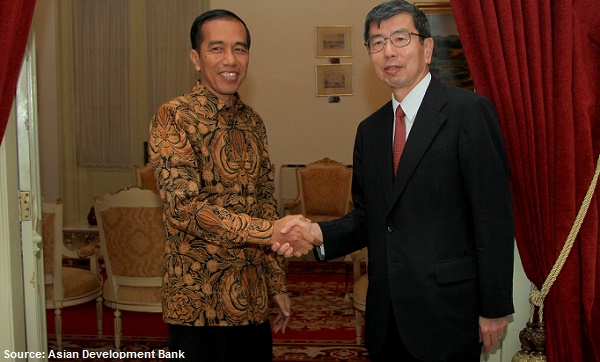ADB Praises Indonesia’s Reform Efforts but GDP Growth Limited in 2015
Takehiko Nakao, President of the Asian Development Bank (ADB), estimates that the Indonesian economy will grow 5.6 percent year-on-year (y/y) in 2015, lower than the target that has been set by the Indonesian government in the 2015 State Budget (5.8 percent y/y). Nakao is slightly less optimistic as he expects a slowdown in government spending this year. On a positive note, Nakao’s forecast implies a sharp improvement in Indonesia’s economic growth in 2015 from an estimated 5.1 percentage point (y/y) GDP growth in 2014.

Last year, Indonesia’s economic growth moderated amid the global economic slowdown and subsequent falling commodity prices. Low commodity prices (such as coal, crude palm oil, and rubber) impact heavily on the export performance of Southeast Asia’s largest economy. Moreover, due to internal rebalancing of the economy the central bank introduced a higher interest rate environment (to combat high inflation and curb the wide current account deficit) thereby curtailing economic growth.
Nakao emphasized that Indonesia’s economic performance in 2015 may surpass his forecast provided that the government, headed by President Joko Widodo, continues to implement structural reforms (such as the recently revised fuel subsidy policy), improves tax collection, accelerates infrastructure development and improves the investment climate. These efforts will boost market confidence in the government’s economic program and the country’s economic fundamentals.
Indonesia's Quarterly GDP Growth 2009–2014 (annual % change):
| Year | Quarter I |
Quarter II | Quarter III | Quarter IV |
| 2014 | 5.22 | 5.12 | 5.01 | |
| 2013 | 6.03 | 5.89 | 5.62 | 5.78 |
| 2012 | 6.29 | 6.36 | 6.16 | 6.11 |
| 2011 | 6.45 | 6.52 | 6.49 | 6.50 |
| 2010 | 5.99 | 6.29 | 5.81 | 6.81 |
| 2009 | 4.60 | 4.37 | 4.31 | 4.58 |
Source: Statistics Indonesia (BPS)
Gross Domestic Product of Indonesia 2006-2013:
| 2006 | 2007 | 2008 | 2009 | 2010 | 2011 | 2012 | 2013 | |
| GDP (in billion USD) |
285.9 | 364.6 | 432.1 | 510.2 | 539.4 | 706.6 | 846.8 | 878.0 |
| GDP (annual percent change) |
5.5 | 6.3 | 6.1 | 4.6 | 6.1 | 6.5 | 6.2 | 5.8 |
| GDP per Capita (in USD) |
1,643 | 1,923 | 2,244 | 2,345 | 2,984 | 3,467 | 3,546 | 3,468 |
Sources: World Bank, International Monetary Fund (IMF) and Statistics Indonesia (BPS)
Today (13/01), Nakao visited both President Widodo and Vice President Jusuf Kalla in Jakarta to discuss the government’s economic reform agenda as well as further cooperation between the ADB and Indonesia. The ADB’s future support for Indonesia will be closely aligned with the country’s forthcoming five-year National Development Plan. The key challenges and tasks of this plan include better infrastructure, attaining food and energy security, and spurring more inclusive economic growth.
The government of Indonesia gives high priority to infrastructure development which includes the strengthening of maritime connectivity through the construction of new ports, roads, airports, dams, irrigation networks, power plants and industrial parks. These investments will require at least USD $500 billion over the next five years. Funds will be collected by tapping public and private resources as well as external financing from international financial institutions. Other ways to generate these funds are to increase tax compliance and the removal of regulatory uncertainties that have blocked private investment in the country’s infrastructure (through public-private partnerships). The ADB pledged its support for Indonesia’s development plan and is committed to disburse at least USD $1.5 billion in loans to support various infrastructure projects.
Nakao also emphasized that further reforms are needed to elevate the country’s human capital through improved education. Although primary school enrollment in Indonesia is high, there are remaining challenges including the quality of education, disparities in educational attendance and attainment between urban and rural areas. There currently is high demand for skilled workers in Indonesia and it is also important to boost labor productivity. About 60 percent of Indonesia’s labour force works in the informal sector and is thus vulnerable to fall (back) into poverty (about 11 percent of the Indonesian population lives below the poverty line).
The website of the ADB mentions that Indonesia received USD $29 billion in sovereign and non-sovereign loans, USD $445 million in technical assistance, and USD $307 million in grants since joining the ADB as a founding member in 1966. ADB’s support has been mainly focused on energy, transport, agriculture and water resource management, education, finance, and water supply and urban development.

